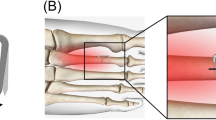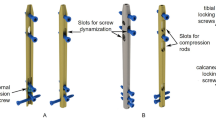Abstract
The use of Nitinol in orthopedic staples has a long, successful history beginning with their first commercial introduction in the early 1980s. Nitinol bone staples are generally inserted through a process of being chilled, opened, and inserted into predrilled holes. Upon insertion, they recover their preprogrammed shape either through springing back after removal of a constraint (using superelasticity) or thermal triggering (using thermal shape memory). In general, Nitinol bone staples fall into one of three categories: (1) those which are superelastic at room temperature, (2) those which recover their shape upon heating to body temperature, or (3) those which recover their shape upon heating above body temperature with the application of an external heat source. These three different design approaches—room temperature superelastic, body temperature activated, and heat activated—each have different performance characteristics. A version of the heat activated staple that uses a controlled heat source appears to have the best combination of clinical forces and procedural control.



Similar content being viewed by others
References
A. Johnson and F. Alicandri, Thermoconstrictive Surgical Appliance, U.S. Patent 3,786,806, 2 Jan 1974
J. Ryhänen, “Biocompatibility Evaluation of Nickel-Titanium Shape Memory Metal Alloy,” Dissertation, Department of Surgery, University of Oulu, Oulu, Finland, 1999
Bargar, W. L., Sharkey, N. A., Paul, H. A., et al, “Efficacy of Bone Staples for Fixation,” J. Orthop. Trauma, Vol. 1, No. 4 (1987), pp. 326–330.
Mereau, T. M. and Ford, T. C., “Nitinol Compression Staples for Bone Fixation in Foot Surgery,” J. Am. Podiatr. Med. Assoc., Vol. 96, No. 2 (2006), pp. 102–106.
Bronzino, J. D., The Biomedical Engineering Handbook, Edition 3 (CRC Press, Boca Raton, FL, 2006), Chap. 63.
Telos Medical Memodyn™ Compression Staple Product Information Available at http://www.telosmedical.com/memodyn.htm
BioMedical Enterprises, Inc. OSSforce™ Implant Controller Product Information Available at http://www.bme-tx.com/Product/OSSforce.html
Shibuya, N., et al, “A Compression Force Comparison Study Among Three Staple Fixation Systems,” J. Foot Ankle Surg., Vol. 46, No. 1 (2007), pp. 7–15.
A.K. Forsythe and C.J. Green, Bone Fracture Compression Device and Method of Usage, U.S. Patent 3,866,607, 18 Feb 1975
Choudhary, R. K., et al, “First Metatarsophalangeal Joint Arthrodesis: A New Technique of Internal Fixation by Using Memory Compression Staples,” J. Foot Ankle Surg., Vol. 43, No. 5 (2004), pp. 312–317.
Braun, J. T., et al, “The Efficacy and Integrity of Shape Memory Alloy Staples and Bone Anchors with Ligament Tethers in the Fusionless Treatment of Experimental Scoliosis,” J. Bone Joint Surg., Vol. 87A, No. 9 (2005), pp. 2038–2051.
Malal, J. J. G., Hegde, G. and Ferdinand, R. D., “Tarsal Joint Fusion Using Memory Compression Staples—A Study of 10 Cases,” J. Foot Ankle Surg., Vol. 45, No. 2 (2006), pp. 113–117.
Ronchetti, P. J. and Topper, S. M., “Lunocapitate Fusion Using the OSStaple Compression Staple,” Tech. Hand Up. Extrem. Surg., Vol. 10, No. 4 (2006), pp. 231–234.
T.J. Chang and B.D. Overley, “An In Vitro Comparative Study of Screw and Nitinol Staple Compression: A Model Showing Active ‘Dynamic’ Compression,” Presented at the American College of Foot & Ankle Surgeons 65th Annual Scientific Conference, Orlando, FL, March 2007.
Fernández-de-Retana, P., Poggio, D. and Ortega, J. P., “Technical Tip: First Metatarsophalangeal Arthrodesis with 20-mm Memory Compression Staples,” Foot Ankle Int., Vol. 29, No. 6 (2008), pp. 613–615.
“Standard Test Method for Determination of Transformation Temperature of Nickel-Titanium Shape Memory Alloys by Bend and Free Recovery,” ASTM F2082-06, ASTM International, West Conshohocken, PA, 2006
Author information
Authors and Affiliations
Corresponding author
Additional information
This article is an invited paper selected from presentations at Shape Memory and Superelastic Technologies 2008, held September 21-25, 2008, in Stresa, Italy, and has been expanded from the original presentation.
Rights and permissions
About this article
Cite this article
Russell, S.M. Design Considerations for Nitinol Bone Staples. J. of Materi Eng and Perform 18, 831–835 (2009). https://doi.org/10.1007/s11665-009-9402-1
Received:
Revised:
Accepted:
Published:
Issue Date:
DOI: https://doi.org/10.1007/s11665-009-9402-1




